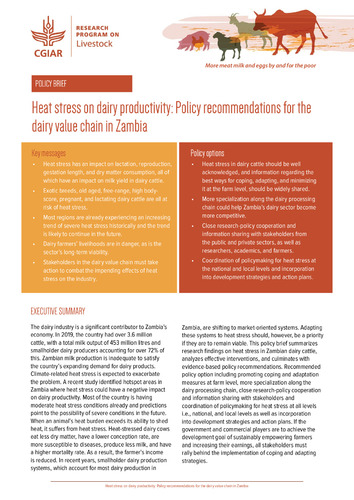Heat stress on dairy productivity: Policy recommendations for the dairy value chain in Zambia
The dairy industry is a significant contributor to Zambia’s economy. In 2019, the country had over 3.6 million cattle, with a total milk output of 453 million litres and smallholder dairy producers accounting for over 72% of this. Zambian milk production is inadequate to satisfy the country’s expanding demand for dairy products. Climate-related heat stress is expected to exacerbate the problem. A recent study identified hotspot areas in Zambia where heat stress could have a negative impact on dairy productivity. Most of the country is having moderate heat stress conditions already and predictions point to the possibility of severe conditions in the future.
When an animal’s heat burden exceeds its ability to shed heat, it suffers from heat stress. Heat-stressed dairy cows eat less dry matter, have a lower conception rate, are more susceptible to diseases, produce less milk, and have a higher mortality rate. As a result, the farmer’s income is reduced. In recent years, smallholder dairy production systems, which account for most dairy production in Zambia, are shifting to market-oriented systems. Adapting these systems to heat stress should, however, be a priority if they are to remain viable. This policy brief summarizes research findings on heat stress in Zambian dairy cattle, analyzes effective interventions, and culminates with evidence-based policy recommendations. Recommended policy option including promoting coping and adaptation measures at farm level, more specialization along the dairy processing chain, close research-policy cooperation and information sharing with stakeholders and coordination of policymaking for heat stress at all levels i.e., national, and local levels as well as incorporation into development strategies and action plans. If the government and commercial players are to achieve the development goal of sustainably empowering farmers and increasing their earnings, all stakeholders must rally behind the implementation of coping and adapting strategies.

